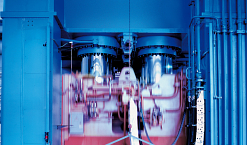
8 steps for obtaining hydraulic power press safety compliance
By Design Engineering staff
Motion Control Fabrication Safety hydraulics maintenanceBosch Rexroth gives eight steps to follow in order to best comply with hydraulic power press safety.

In February, Bosch Rexroth Canada offered a free Hydraulic Power Press Safety seminar on how to achieve hydraulic press worker safety that meets regulatory standards. It focused on applying specialized systems, techniques and components to maximize safety and regulatory compliance for managers, plant engineers, maintenance specialists and machine builder design engineers in any industry that uses large hydraulic power presses, including automotive, commercial goods and others.
To enlighten those who did not or could not attend, seminar presenter Steve Storoni, Industrial Hydraulics Engineering Manager at Bosch Rexroth, gives Design Engineering readers eight steps to follow in order to best comply with hydraulic power press safety:
1. Know your role
The ultimate responsibility and liability for a safe hydraulic press system lies with the employers, owners or lessees of the machine—however, each contributing party to the system are liable for their individual supply.
2. Understand the current legislation, policing method and standards
In Canada, relative legislation is documented via the OHSA (Occupational Health and Safety Act, R.S.O. 1990, c. O.1), specifically OHSA R.R.O. 1990, Regulation 851 for industrial establishments. The Ministry of Labour’s (MOL) industrial health and safety inspectors and engineers enforce the laws and can enter an industrial establishment without advanced notice. Applicable standards for hydraulic presses are covered by CSA Z432 (a type B standard) and by CSA Z142 (a type C – machine-specific standard).
3. Know when a PSR is required
There is no such thing as “grandfathering” a machine. If someone is injured or killed by a machine, litigation will refer to the latest and greatest safety standards and regulations. When a new machine, relocated machine or modified machine is considered, a Pre-Start Safety and Health Review (PSR) is required before the machine can be operated.
It is best to have a PSR completed first on a machine that the employers, owners or lessees are planning to modify to meet current safety regulations since the professional engineer which will be engaged to produce the PSR report have their own personal interpretation of the standards and thus it is best to sort through the correct solution with them and the potential sub-suppliers prior to purchasing any goods and/or modifying the machine to ensure that all concerns are attended to in the planning stage.
